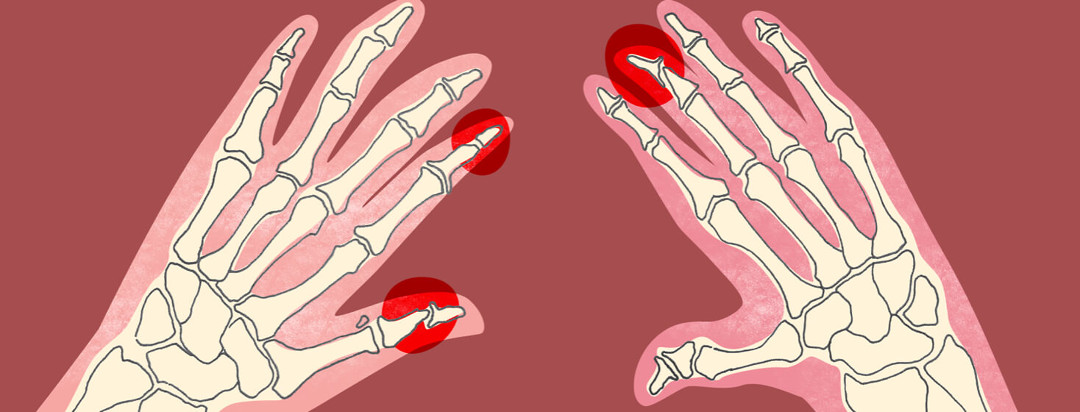Pencil-in-Cup Deformity and Psoriatic Arthritis
Even though it is very rare, some people with psoriatic arthritis (PsA) can experience a severe form of the disease known as psoriatic arthritis mutilans (PAM). PAM only affects about 5 percent of people with PsA. It is a severe form of arthritis that causes joint and bone loss. It can also lead to permanent damage in the fingers, toes, hands, and feet. Normally, when bone cells break down, they are able to rebuild. For people with PAM, the bones cannot rebuild. Instead, the soft tissue collapses.1,2
PAM and pencil-in-cup deformity
For patients with PAM, as the bones and joints begin to break down and dissolve, they can often look deformed. Sometimes, patients will develop a “telescoping finger.” This is when the bones dissolve so severely that the soft tissues cannot hold the fingers up. They then look like a telescope.
“Opera glass hand” can also occur. This is when you pull on the affected fingers and they look like the opening of opera glasses. In other cases, “pencil-in-cup” deformity occurs. This is when the end of the bone has been whittled down into a pinpoint, like a pencil. This sharp edge wears away the surface of the connecting bone into a cup shape.1-4
Pencil-in-cup deformity occurs when psoriatic arthritis becomes so severe that bone tissue breaks down and is permanently destroyed. Sometimes, this can be seen in a doctor’s office during an exam. It is more commonly discovered on X-rays of the joints. Doctors think that PAM and pencil-in-cup deformity can happen as PsA progresses over time. Since X-rays are often not taken during doctor visits, this progression can be overlooked.2
What causes pencil-in-cup deformity?
The cause of PAM or pencil-in-cup deformity is not known. People with PsA are more likely to develop this more severe form of arthritis. But even most people with PsA will not get PAM or pencil-in-cup deformity. Doctors think that, like PsA, PAM could be related to a family history of disease. Environmental triggers and other inflammatory conditions could also lead to PAM. Since it is connected to advanced disease progression, untreated PsA may also be a reason a patient can develop either of these conditions.1,5
Symptoms
PAM and pencil-in-cup deformity are caused by the breakdown of bone tissue and the body’s reabsorption of the bone. Signs and symptoms of this breakdown include:3
- Shortening and bunching together of the fingers or toes
- Bunched up, loose skin over shortened fingers or toes
- Difficulty or inability to move the hands or feet
- Fused bones, also known as ankylosis
- Other deformities in the fingers or toes
Diagnosis
Doctors may be able to recognize pencil-in-cup deformity through a physical exam. However, X-ray is a better way to diagnose this severe form of PsA. X-rays can show if there has been damage to the joints or reabsorption of bone tissue. X-rays also show the pencil-in-cup shape of the joint and connecting bone and may be able to identify PAM or pencil-in-cup deformity earlier than a traditional physical exam.2,5
Treatment
Unfortunately, there is no specific treatment for PAM or pencil-in-cup deformity. Still, medications for PsA may help slow or stop joint damage or bone loss. These medications include:2
- Biologics – medications that target the immune system and prevent flares and reduce the symptoms of PsA
- DMARDs – anti-inflammatory medications that reduce inflammation and slow down an overactive immune system
- Anti-inflammatory drugs (NSAIDs) – medications such as ibuprofen, naproxen, or aspirin may reduce pain
Physical therapy may also help patients with PAM or pencil-in-cup deformity. Physical therapy can help increase the mobility of the joints, reduce inflammation, and possibly slow down the progression of disease.2
Prevention of pencil-in-cup deformity
Since the cause is unknown and there is no specific treatment for PAM or pencil-in-cup deformity, prevention is key. More frequent X-rays and joint damage assessments may help identify this severe form of PsA early. This could potentially lead to treatment that may prevent severe joint destruction.2

Join the conversation